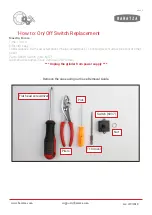
RG165T-R Operator · Service · Maintenance
18
• Never move this machine, or make adjustments or repairs,
while the engine is running.
Slope Operation
Machines that are operating safely in various applications
depend on these criteria: the machine model, configuration,
machine maintenance, operating speed of the machine,
conditions of the terrain, fluid levels, and tire inflation
pressures. The most important criteria are the skill and
judgment of the operator.
A well trained operator that follows the instructions in the
Operation and Maintenance Manual has the greatest impact
on stability. Operator training provides a person with the
following abilities: observation of working and environmental
conditions, feel for the machine, identification
of potential hazards, and operating the machine safely by
making appropriate decisions.
When you work on side hills and when you work on slopes,
consider the following important points:
• Speed of travel – At higher speeds, forces of inertia
tend to make the machine less stable.
• Roughness of terrain or surface – The machine may be
less stable with uneven terrain.
• Direction of travel – Avoid operation the machine across
the slope. When possible, operate the machine up
the slopes and operate the machine down the slopes.
• Place the heaviest end of the machine uphill when you
are working on an incline.
• Mounted equipment – Balance of the machine may be
impeded by the following components: equipment that
is mounted on the machine, machine configuration,
weights, and counterweights.
• Nature of surface – Ground that has been newly filled
with earth may collapse from the weight of the machine.
• Surface material – Rocks and moisture of the surface
material may drastically affect the machine’s traction and
machine’s stability. Rocky surfaces may promote side
slipping of the machine.
• Slippage due to excessive loads – This may cause
downhill tracks or downhill tires to dig into the ground,
which will increase the angle of the machine.
• Width of tracks or tires – Narrower tracks or narrower
tires further increase the digging into the ground which
causes the machine to be less stable.
• Implements attached to the machine hitch or drawbar
– This may decrease the weight on the uphill tracks.
This may also decrease the weight on the uphill tires.
The decreased weight will cause the machine to be
less stable.
• Height of machine working load. When the working loads
are in higher positions, machine stability is reduced.
• Operated equipment – Be aware of performance
features of the equipment in operation and the effects
on machine stability.
• Operating techniques – Keep all attachments or pulled
loads low to the ground for optimum stability.
• Machine systems have limitations on slopes – Slopes can
affect the proper function and operation of the various
machine systems. These machine systems are needed
for machine control on slopes.
• Note: Safe operation on steep slopes may require special
machine maintenance. Excellent skill of the operator
and proper equipment for specific applications are
also required. Consult the Operation and Maintenance
Manual sections for the proper fluid level requirements
and intended machine use.
Work Tool options - Attachments
Only use work tools that are approved by Rayco for use on
Rayco machines. Refer to the Operation and Maintenance
Manual, Rayco options.
If you are in doubt about the compatibility of a particular work
tool with your machine, consult your Rayco dealer.
Make sure that all necessary guarding is in place on the host
machine and on the work tool.
Always wear protective glasses. Always wear the protective
equipment that is recommended in the work tool’s operation
manual. Wear any other protective equipment that is required
for the operating environment.
To prevent personnel from being struck by flying objects,
ensure that all personnel are out of the work area.
While you are performing any maintenance, any testing, or
any adjustments to the machine, stay clear of the follow-
ing areas: cutting edges, pinching surfaces, and crushing
surfaces.
Equipment Lowering with Engine
Stopped
Before lowering any equipment with the engine stopped,
clear the area around the equipment of all personnel. The
procedure to use will vary with the type of equipment to be
lowered. Keep in mind this system use a high pressure fluid
to raise or lower equipment. The procedure will cause high
pressure hydraulic oil to be released in order to lower the
equipment. Wear appropriate personal protective equipment
and follow the established procedure in the Operation and
Maintenance Manual.
Safety
NOTICE
This machine is to be utilized in an up/down
gradient (not across an angle).
Содержание RG165T-R
Страница 23: ...RG165T R Operator Service Maintenance 800 392 2686 23 Safety ...
Страница 24: ...RG165T R Operator Service Maintenance 24 Operation 11 7 1 3 2 5 6 8 4 9 10 12 13 14 15 16 ...
Страница 47: ...RG165T R Operator Service Maintenance 800 392 2686 47 Maintenance ...
Страница 62: ...RG165T R Operator Service Maintenance 62 Hydraulic Schematic 806797 TOP ...
Страница 63: ...RG165T R Operator Service Maintenance 800 392 2686 63 Hydraulic Schematic 806797 TOP BOTTOM ...
Страница 69: ...RG165T R Operator Service Maintenance 800 392 2686 69 ...
















































